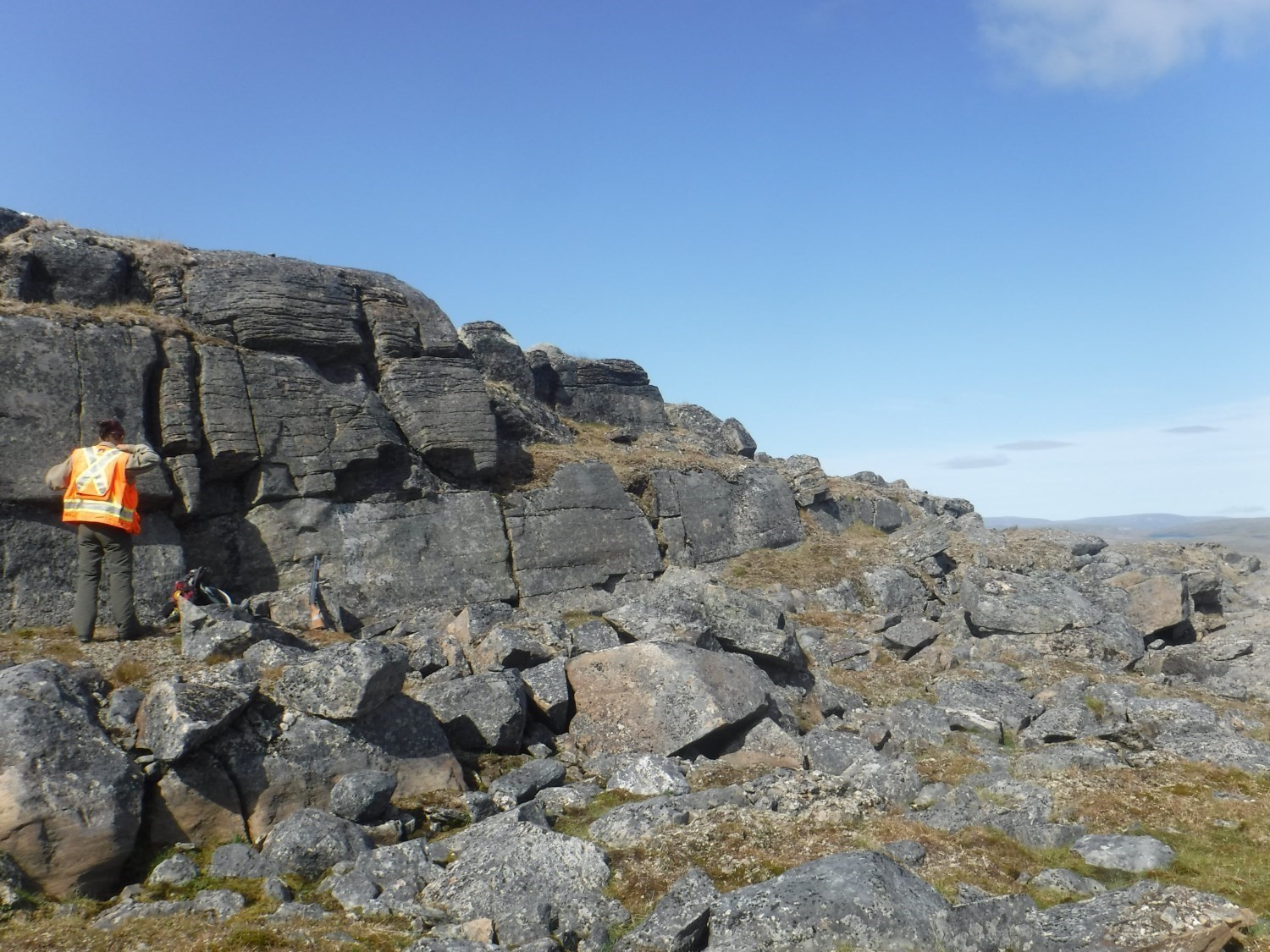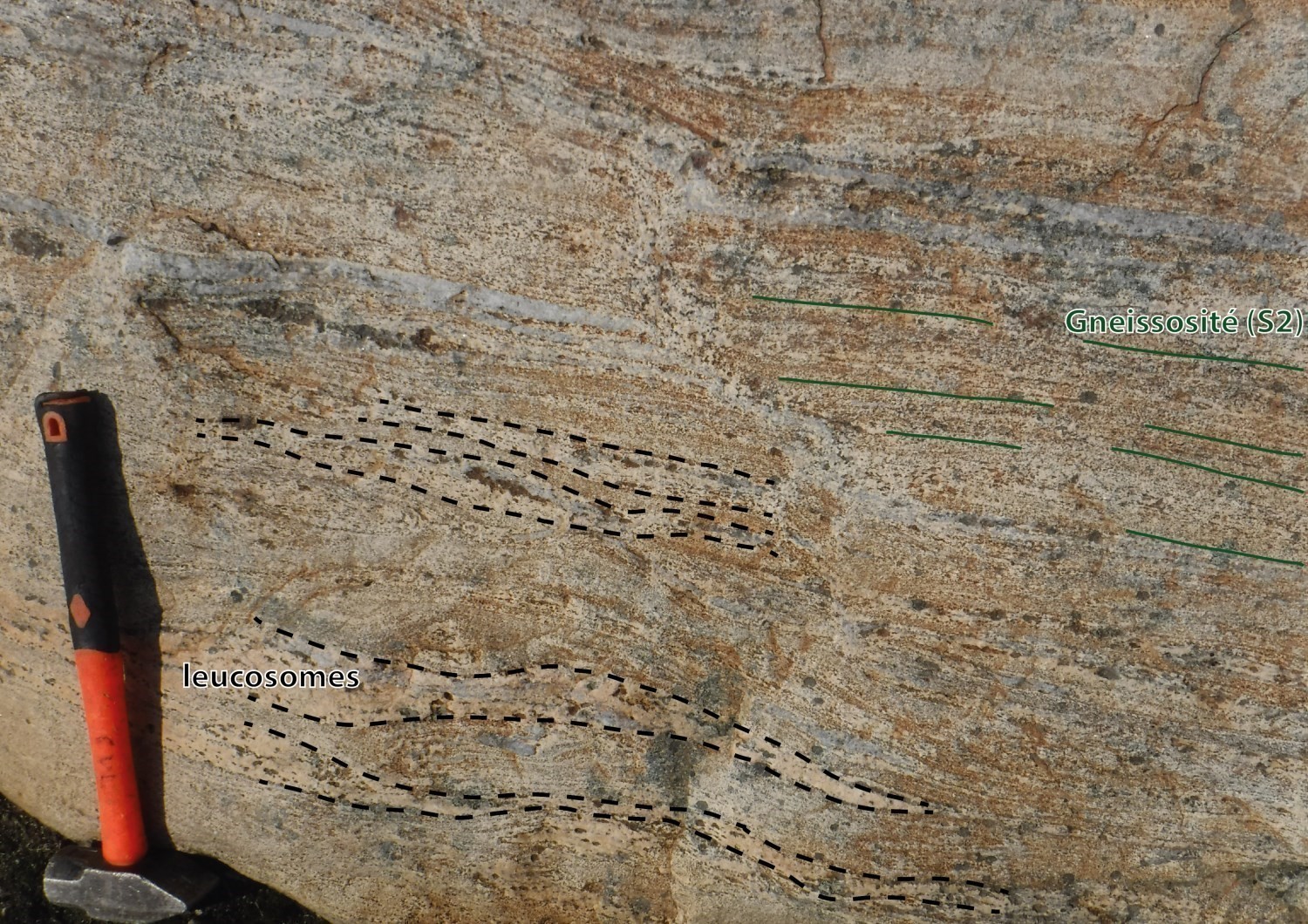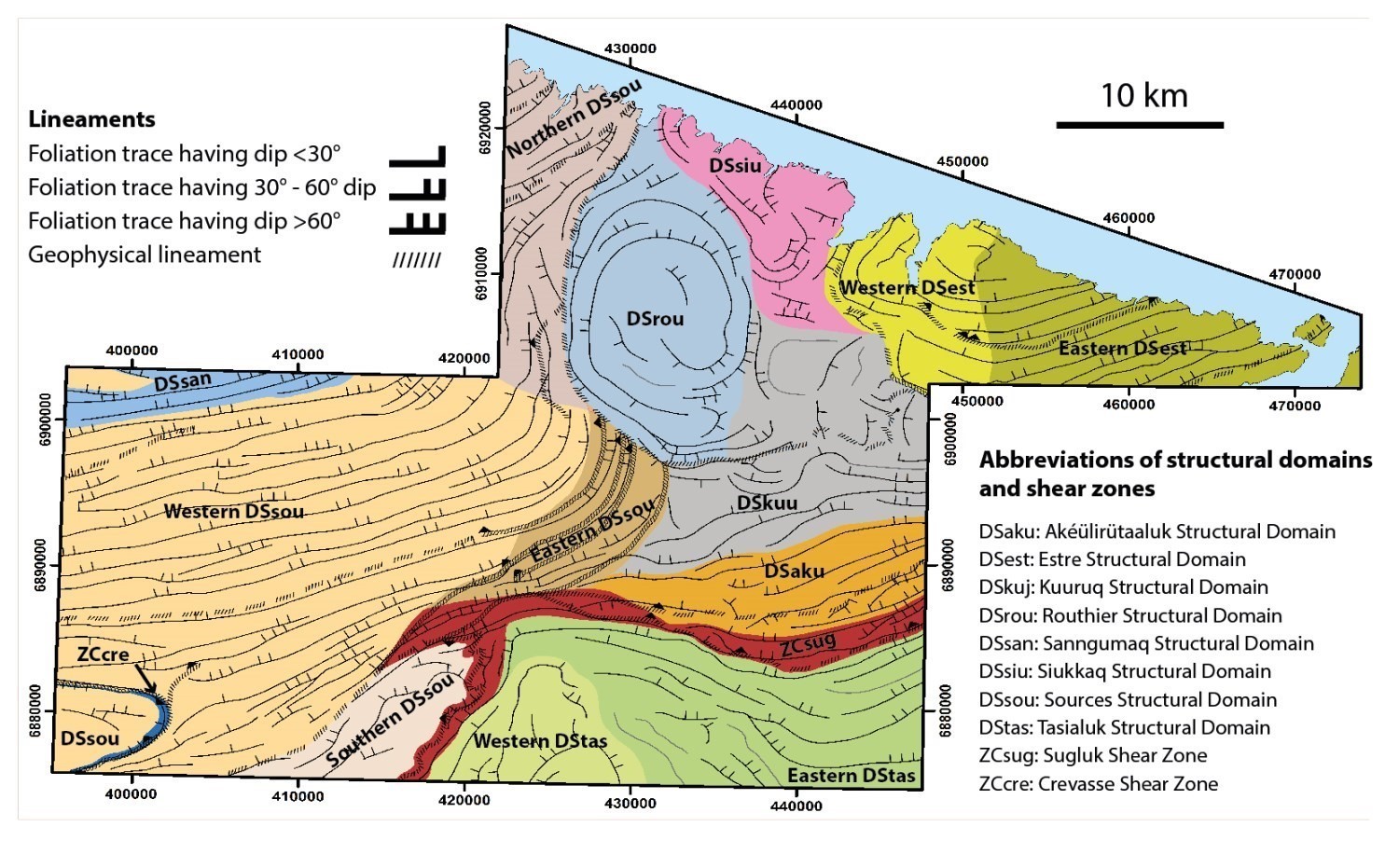
| Author(s) | Vanier and Lafrance, 2020 |
| Methodology | Defined from geological survey and geophysical data |
| Geological(s) subdivision(s) | Churchill Province / Ungava Orogen / Narsajuaq Lithotectonic Domain |
| Main movement | Reverse dextral |
| Deformation style | Parallel; mainly foliated to gneissic rocks affected by penetrative deformation of moderate intensity charaterized by a continuous, straight and parallel fabric. |
| Metamorphic facies (mean facies related to main deformation) | Granulites |
Background and Methodology
This record is based on interpretation of geophysical imaging and information collected from geological survey carried out in the summer of 2019 in the Sirmiq Lake area (Vanier and Lafrance, 2020).
Boundaries and Morphology
| Width | ~25 km |
| Length | ~55 km |
| Orientation | WSW to S |
The NE part of the Sources Domaine (DSsou) is bordered by the Hudson Strait and the Routhier Structural Domain (DSrou) forming a dome. The interface with the latter possibly corresponds to a shear zone of indeterminate nature. The eastern part of the DSsou is also in contact with the Kuuruq Structural Domain (DSkuu). This contact is marked by a change in foliations’ dip which are subhorizontal to the east, in the Kuuruq Domain. In the southern part of the DSsou, the intensity of deformation gradually increases near the boundary with the Sugluk Shear Zone (SZCsug). The attitude of the main fabrics and the kinematics are similar for these two structural units, but the Sugluk Shear Zone is characterized by more intense and less diffuse deformation. The Sources Structural Domain continues to the west and north (outside the area mapped in 2019) and likely extends to Hudson Bay to the west, and to the Naujaat Shear Zone to the north.
Stratigraphic Units Concerned
Structural attributes of the DSsou are recorded within the main metamorphosed intrusive rocks of the Narsajuaq Lithotectonic Domain, mainly the Estre and Pingasualuit complexes and the Navvaataaq Suite. Similarly, they are observed in metasedimentary rocks of the Erik Cove Complex and the Paleoproterozoic Frichet, Suluraaq and Sanningajualuk intrusive suites.
Structural Characteristics
Most of the outcrops belonging to the Sources Domain display a tectometamorphic foliation or gneissosity containing a stretch or mineral lineation. These fabrics are easily correlated between outcrops. Thus, the foliation trace was defined by combining aeromagnetic lineaments with structural measurements taken in the field. The latter is parallel to geological contacts. In addition, no fabric superimposition was observed on outcrops. Thus, all structural measurements correspond to Sn and Ln fabrics. The DSsou has been divided into four subdomains in order to better represent certain areas affected by regional bends in the structural grain.
❯ Main Fabrics
 Planar fabrics are commonly characterized by an alignment of ferromagnesian minerals, regardless of the type of lithology. Within banded or gneissic rocks, compositional variations in the bands also highlight the planar fabric, as do stromatic textures found in metatexites. Some more intensely deformed outcrops show straight gneissosity and important stretching of quartz which forms elongated lenses. This type of fabric is mainly present in the northern and southern parts of the Sources Domain. The stretch lineation is mainly defined by quartz, although feldspar may also show stretching. As for mineral lineation, it is defined by the alignment of ferromagnesian minerals.
Planar fabrics are commonly characterized by an alignment of ferromagnesian minerals, regardless of the type of lithology. Within banded or gneissic rocks, compositional variations in the bands also highlight the planar fabric, as do stromatic textures found in metatexites. Some more intensely deformed outcrops show straight gneissosity and important stretching of quartz which forms elongated lenses. This type of fabric is mainly present in the northern and southern parts of the Sources Domain. The stretch lineation is mainly defined by quartz, although feldspar may also show stretching. As for mineral lineation, it is defined by the alignment of ferromagnesian minerals.
 The general attitude of DSsou fabrics is best defined by those in the western part of the DSsou, which includes the largest number of measurements and occupies the largest area. The planar fabric there is on average 255°/48° and the lineation 288°/32°. The dispersion of measurements around these average values is also low. Lineations are commonly close to the foliation’s slope line and slightly offset westwards. In the eastern part of the DSsou, foliations are slightly curved towards the SW, while the linealation is closer to the slope line and keeps a NW direction. This bending becomes more pronounced in the northern part of the DSsou, where the average foliation becomes 208°/38° and the slope line is 277°/31°. The southern part of the DSsou is restricted in space and contains a limited number of measurements. The foliation there is similar to that of the western part of the DSsou. On the other hand, the lineation is scattered and it is impossible to define an average value.
The general attitude of DSsou fabrics is best defined by those in the western part of the DSsou, which includes the largest number of measurements and occupies the largest area. The planar fabric there is on average 255°/48° and the lineation 288°/32°. The dispersion of measurements around these average values is also low. Lineations are commonly close to the foliation’s slope line and slightly offset westwards. In the eastern part of the DSsou, foliations are slightly curved towards the SW, while the linealation is closer to the slope line and keeps a NW direction. This bending becomes more pronounced in the northern part of the DSsou, where the average foliation becomes 208°/38° and the slope line is 277°/31°. The southern part of the DSsou is restricted in space and contains a limited number of measurements. The foliation there is similar to that of the western part of the DSsou. On the other hand, the lineation is scattered and it is impossible to define an average value.
| Main Fabric | Type of Fabric | Direction (°) | Dip / Plunge (°) | Number of Measurements | Comments |
| Foliation Sn | Tectonometamorphic foliation and gneissosity | 208 | 38 | 41 | Northern part |
| Linéation Ln | Stretch or mineral lineations | 277 | 31 | 18 | Northern part |
| Foliation Sn | Tectonometamorphic foliation and gneissosity | 255 | 48 | 203 | Western part |
| Linéation Ln | Stretch or mineral lineations | 288 | 32 | 58 | Western part |
| Foliation Sn | Tectonometamorphic foliation and gneissosity | 226 | 33 | 34 | Eastern part |
| Linéation Ln | Stretch or mineral lineations | 303 | 29 | 29 | Eastern part |
| Foliation Sn | Tectonometamorphic foliation and gneissosity | 238 | 38 | 16 | Southern part |
| Linéation Ln | Stretch or mineral lineations | variable | variable | 6 | Southern part |
❯ Other Fabrics
Not observed.
❯ Folds
Overall, the Sources Structural Domain is not characterized by the presence of folds. However, open folds with long flanks dipping towards the NW have been observed in the eastern part of the DSsou. These folds explain the few foliation measurements whose dip is in the SE direction. In addition, the repetition of stratigraphic units acting as marker layers, such as quartzite strips of the Erik Cove Complex, could be interpreted as indicating the presence of folds of similar style at the scale of the DSsou, but their existence remains to be demonstrated.
❯ Crosscutting Relationships
None.
❯ Kinematics
Within the DSsou, some more intense deformation zones contain kinematic indicators. These are mainly present in the eastern part of the DSsou and indicate a reverse movement similar to that observed in the Sugluk Shear Zone (ZCsug). The presence of kinematic indicators in neosomes of migmatites indicates that reverse shearing is contemporaneous with migmatization.
| Type | Direction (°) (Mean) | Dip(°) (Mean) | Lineation Plunge in the Fault Plane | Apparent Movement | Kinematic Indicators | Comments |
| Regional shear | 226 | 33 | 90 | Sinistral | Sigma-type porphyroclasts | Kinematic indicators are mainly present in the eastern part of the DSsou; the apparent movement is observed with the view to the west. |
Deformation Style
The entire Sources Structural Domain is affected by a moderate to intense penetrative deformation characterized by a parallel fabric continuous between outcrops. In addition, a stretch or mineral lineation is commonly visible. Deformation and metamorphism have obliterated almost all the original stratigraphic relationships. They have also made several protoliths difficult to recognize as they have been transformed into gneiss or stromatic metatexite. This style of unfocused, penetrative deformation with high metamorphic grade is interpreted as an indicator of ductile flow in medium or lower crust (Vanier and Lafrance, 2020).
Metamorphic Characteristics
Field and microscopic observations indicate that the DSsou recorded metamorphism at the granulite facies and that the main deformation took place under these conditions. In outcrop, the presence of stromatic banding parallel to foliation indicates the occurrence of anatectic conditions during deformation (Sawyer, 2008). Leucosomes present within metatexites commonly contain lenticular quartz marking stretch lineation and foliation. Thus, part of the deformation also occurred under subsolidus conditions.
Observation of quartz and feldspar textures allow to better constrain thermal conditions during deformation. Quartz forms lenticular aggregates of amoeboid to interlobed grains or bands of elongated grains whose ratios are usually greater than 1:5. Pinching is regularly observed with neighbouring minerals, particularly biotite. These textures are indicative of dynamic quartz recrystallization by grain edge migration (Guillope and Poirier, 1979; Urai et al., 1986; Jessel, 1987). This mechanism occurs at temperatures >500°C (Kruhl, 1998; Stipp et al., 2002). Chessboard extinctions, known to form usually at >600°C (Lister and Dornsiepen, 1982; Mainprice et al.., 1986), support high deformation temperatures.
As for feldspar, it occurs as core and mantle, which consists of one or a few old amoeboid-shaped grains having undulatory extinction surrounded by a mosaic of polygonal grains formed by dynamic recrystallization. This type of texture indicates recrystallisztion by subgrain rotation (Guillope and Poirier, 1979; Hirth and Tullis, 1992), which occurs at temperatures >500 °C (Passchier and Trouw; 2005). Finally, metamorphic peak minerals, namely garnet, orthopyroxene and sillimanite, mainly dispaly synkinematic textures.
A few tens representative samples from the DSsou show these types of textures, attesting to the homogeneity of high thermal conditions during deformation.
Alterations
Does not apply.
Geophysical Characteristics
The Sources Domain is made up of a series of parallel and straight magnetic ridges which give it a highly banded appearance. This banding has allowed to constrain foliation traces associated with it.
Chronological Markers
The only unit that cuts fabric of the DSsou is the Sanningajualuk Suite, of which a sample taken outside the structural domain has been dated at 1800 ±2 Ma (Parrish, personal communication, 1994). Metamorphic ages obtained for the main units of the Narsajuaq Lithotectonic Domain, and possibly affected by the same deformation event, may provide more revealing temporal constraints. In fact, deformation took place at thermal conditions close to metamorphic paroxysm. In addition, metatexites display stromatic textures parallel to foliation. Within the Narsajuaq Domain, metamorphic ages of 1806 ±38 Ma (Navvaataaq Suite), 1880 ±2 Ma and 1841 ±2 Ma (Pingasualuit Complex; Davis and Sutcliffe, 2018) were obtained.
References
Publications Available Through Sigéom Examine
DAVIS, D W., SUTCLIFFE, C.N., 2018. U-Pb Geochronology of Zircon and Monazite by LA-ICPMS in Samples from Northern Quebec. UNIVERSITY OF TORONTO. MB 2019-01, 113 pages.
VANIER, M.-A., LAFRANCE, I. 2019., Géologie de la région du lac Sirmiq, Orogène de l’Ungava, Nunavik, Québec, Canada. MERN. BG 2020-02, 1 plan.
Other Publications
GUILLOPE, M., POIRIER, J.P., 1979. Dynamic recristallization during creep of single crystaline halite: an experimental study. Journal of Geophysic Research; volume 84, pages 5557-5567. https://doi.org/10.1029/JB084iB10p05557
HIRTH, G., TILLIS, J., 1992. Dislocation creep regimes in quartz aggregates. Journal of Structural Geology; volume 14, pages 145-159. doi.org/10.1016/0191-8141(92)90053-Y
JESSELL, M.W., 1987. Grain-boundary migration microstructures in a naturally deformed quartzite. Journal of Structural Geology; volume 9, pages 1007-1014. doi.org/10.1016/0191-8141(87)90008-3.
KRUHL, J.H., 1996. Prism- and basal-plane parallel subgrain boundaries in quartz: a microstructural geothermobarometer. Journal of Metamorphic Geology; volume 14, pages 581-589. doi.org/10.1046/j.1525-1314.1996.00413.x
LISTER, G.S., DORNSIEPEN, U.F., 1982. Fabric transitions in the Saxony granulite terrain. Journal of Structural Geology; volume 4, pages 81-92. doi.org/10.1016/0191-8141(82)90009-8
MAINPRICE, D., BOUCHEZ, J-L., BLUMENFELD, P., TUBIÀ, J.M., 1986. Dominant c slip in naturally deformed quartz: Implication for dramatic plastic softening at high temperature; volume 14, pages 819-822. doi.org/10.1130/0091-7613(1986)14<819:DCSIND>2.0.CO;2
PASSCHIER, C.W., TROUW, R.A.J., 2005. Microtectonics, 2nd ed. Springer, Berlin, 366 pages.
SAWYER, E.W., 2008. Atlas of migmatites. NRC Research press, 2008. 371 pages.
STIPP, M., STÜNIZ, H., HEILBRONNER, R., SCHMID, S.M., 2002. The eastern Tonale fault zone: a natural laboratory for crystal plastic deformation of quartz over a temperature range from 250 to 700 °C. Journal of Structural Geology; volume 24, pages 1861-1884. doi.org/10.1016/S0191-8141(02)00035-4
URAI, J.L., MEANS, W.D., LISTER, G.S., 1986. Dynamic recrystallization of minerals. Mineral Rock Deformation Laboratory Studies; volume 36, pages 161-199. doi.org/10.1029/GM036p0161
Suggested Citation
Ministère de l’Énergie et des Ressources naturelles (MERN). Sources Structural Domain. Quebec Structural Lexicon. https://gq.mines.gouv.qc.ca/lexique-structural/domaine-structural-des-sources_en/ [accessed on Day Month Year].
Contributors
|
First publication |
Marc-Antoine Vanier, Jr. Eng., M.Sc. marc-antoine.vanier@mern.gouv.qc.ca; Isabelle Lafrance, P. Geo., M.Sc. isabelle.lafrance@mern.gouv.qc.ca (redaction); Ghyslain Roy, P. Geo. (coordination); James Moorhead, P. Geo., M.Sc. (critical review); Simon Auclair, P. Geo., M.Sc. (editing); André Tremblay (HTML editing); Céline Dupuis, P. Geo., Ph.D. (English version) |



